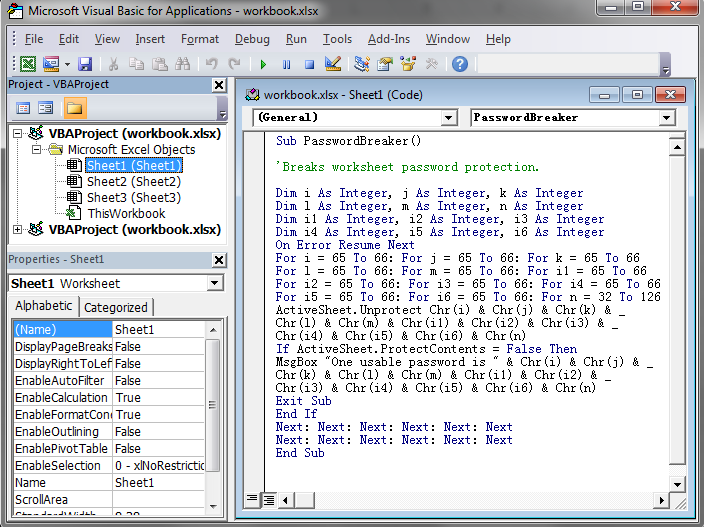5 Ways to Unprotect Excel Sheets: Password Recovery Tips

Discovering how to unprotect Excel sheets can be a lifesaver when you find yourself locked out of your own spreadsheets. Whether you've forgotten the password or inherited a protected file without the key, there are several methods you can employ to recover or remove passwords. In this post, we'll explore 5 effective ways to unprotect Excel sheets, providing you with the tools and techniques to regain access to your crucial data.
Method 1: Using Zip Extractor

If you have access to the .xls or .xlsx file, one surprising trick is using a Zip extractor to bypass the protection:
- Change the file extension from .xlsx to .zip.
- Use a zip utility to unzip the file.
- Navigate to xl > worksheets > sheet1.xml to find the sheet's protection status.
- Edit sheetProtection tags to remove or alter the protection.
- Recompress the folder, change the file extension back to .xlsx, and open it in Excel.
⚠️ Note: This method might not work for all versions of Excel or files with different protection settings.

Method 2: Utilizing VBA Code

For those comfortable with VBA (Visual Basic for Applications), there’s a code snippet that can unprotect sheets:
Sub UnprotectSheets()
Dim WSheet As Worksheet
For Each WSheet In Worksheets
On Error Resume Next
WSheet.Unprotect Password:="123"
On Error GoTo 0
Next WSheet
End Sub
- Open the Excel workbook.
- Press Alt + F11 to open VBA editor.
- Insert a new module and paste the code.
- Run the macro to unprotect all sheets.
Remember, this is a basic macro, and the password "123" can be changed to any password you think might work.
Method 3: Password Recovery Software

When all else fails, password recovery tools can be the knight in shining armor. Programs like Excel Password Recovery Lastic or iSeePassword Excel Password Recovery offer various methods:
- Brute Force: Tries every possible combination.
- Dictionary Attack: Uses a predefined list of common passwords.
- Smart Attack: Uses patterns or user-provided hints to crack the password.
🔒 Note: The effectiveness of these tools depends on the complexity of the password and the strength of the encryption used by Excel.
Method 4: Macro to Try Passwords

Another method involves creating a macro to try multiple passwords:
Sub TryPasswords()
Dim password As String
password = "123456"
Do While password < "ZZZZZZ"
On Error Resume Next
ActiveSheet.Unprotect password
If Err.Number = 0 Then
MsgBox "Password is " & password
Exit Sub
End If
Err.Clear
password = StrReverse(password)
If Len(password) = 6 Then
password = Left(password, 1) & Right(password, 5) & Chr(Asc(Mid(password, 2, 1)) + 1)
ElseIf Len(password) = 7 Then
password = Left(password, 1) & Mid(password, 3, 5) & Chr(Asc(Mid(password, 2, 1)) + 1)
End If
password = StrReverse(password)
Loop
End Sub
- This macro starts with "123456" and tries all possible permutations until it finds the correct password or reaches "ZZZZZZ".
Method 5: Manual Inspection

Sometimes, the simplest approach can work:
- Look for any notes or emails where the password might be noted.
- Check the backup versions of the file if available.
- Examine any related documents for potential password hints.
🔍 Note: Manual inspection should be the first step before attempting any technical methods.
We've covered five ways to unprotect Excel sheets, offering a range of techniques from simple manual checks to advanced password recovery tools. While some methods are straightforward, others require more technical knowledge or specialized software. Always remember that these methods are intended to help recover access to your own data or recover from forgotten passwords. Ethical considerations are crucial; ensure you have the right to access the files you are trying to unprotect.
Is it legal to unprotect an Excel sheet?

+
It is legal to unprotect an Excel sheet if you are the owner of the file or have authorization to access it. Unauthorized access or attempting to bypass someone else’s protection without permission could be considered illegal.
What are the risks of using third-party software to remove Excel protection?

+
Using third-party software carries risks such as potential data breaches, malware infection, or unintended file corruption. Always ensure you download software from reputable sources and back up your data before proceeding.
Can I recover passwords for sheets protected by third-party add-ins?

+
It’s less likely to recover passwords for sheets protected by third-party add-ins since they might use unique encryption algorithms. The methods provided here are more suited for Excel’s default protection mechanisms.